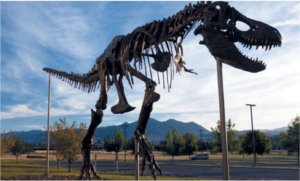Once upon a time, an original Picasso on the living room wall was more than adequate proof that the owner had successfully summited the economic peaks. Now, the work of famous artists is no longer proof of stratospheric wealth. Instead, high-end decorators hired by the wealthy are busily tracking down T. Rex teeth on eBay, bidding millions at Christie’s Auction House for mounted mammoth skeletons, or competing for foot–high dinosaur eggs. How else do you add interest to the den, drama to the entry hall, and curiosity to the coffee table? Fabergé eggs be gone!
Dinosaur decorating has come of age, according to a recent article in the Wall Street Journal, but it has also caused an uproar among many scientists and academics. Paleontologists such as world-famous Jack Horner at Montana State University’s Museum of the Rockies, say commercial fossil hunters dig up the bones too fast and do not take proper field notes, resulting in a huge disservice to science and the destruction of invaluable knowledge about past life on earth.
Horner recognizes that this burgeoning interest in dinosaur fossils is being driven by the market. And that market developed in response to a long, scorching drought across the western plains that has forced many ranchers to sell off their cattle. Left behind are piles of crumbling prehistoric rock and eroded hillsides that contain fossils of saber tooth tigers and horses the size of dogs that lived 33 million years ago.
In Winifred, Montana, farmer Larry Tuss, gave up on wheat and barley and decided to concentrate on the bones in his backyard. He has found five dinosaurs on his property, including a duck-billed hadrosaur, two long-necked, sea-dwelling Plesiosaurs, and a Certopian, which resembles a Triceratops. These are all being readied for sale by a fossil company. While special permits are required to dig on public lands, private landowners strike their own deals with both hobbyists and private firms. Typically the owners give access to their land in exchange for 10 to 50 percent of the profits from any major finds.
Bucky Deflinger, 29, of Faith, South Dakota, made out well. He spotted some humongous teeth protruding from a hillside on his father’s land; they belonged to two T. Rexes. One now resides at the Children’s Museum in Indianapolis. And for his sharp eyesight, Bucky ended up pocketing half a million dollars on the deal, even after splitting the proceeds with the fossil excavating company.
While scientists generally remain unhappy with the market in dinosaur fossils, private landowners on barren stretches of the western plains are glad to have something to take to the bank.



